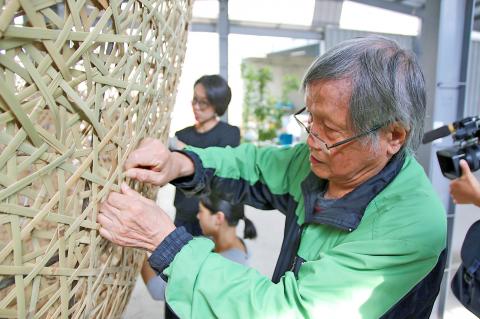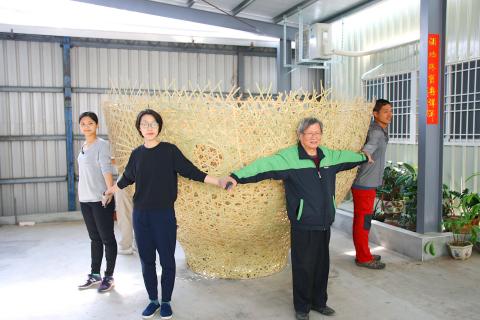The Taiwan Ceramics Cultural Association will hold the inaugural Taiwan International Chawan Festival at the Northern Miaoli Art Center between Nov. 1 and 17. The festival will bring together nearly 350 “chawan” (tea bowls) made by 73 ceramicists from 18 different countries, including Taiwan. Straddling artistic disciplines, the festival’s organizers have collaborated with bamboo weaving master Chang Hsien-ping to commission a massive bamboo wicker “chawan,” which is so large that it needs seven people joining hands to fully surround its circumference.
In 2016, Miaoli County’s Zhunan Snake Kiln — and the wider Taiwanese wood-fired ceramic art industry — was propelled to international fame when second-generation kiln master Lin Jui-hwa set a new Guinness World Record for the highest temperature in a wood-fired kiln, firing to a scorching 1,563 degrees Celsius. Through organizing the festival, the team of artisans who run the Zhunan Snake Kiln hope to create an international platform for arts and crafts, which also showcases to the world the unique artistic qualities of Taiwan’s contemporary tea bowl and tea ceremony culture.
To celebrate the opening of the festival, master bamboo weaver Chang, together with a team of three art students, Huang Wen-chi, Wu Chi-min and Yang Ya-hsueh, took one month to create the 1.7m tall, 2.8m diameter world-class wicker tea bowl. Chang says it is the single largest piece that he has ever produced, which is made using purely traditional weaving techniques. The jumbo “chawan,” whose chinks within the latticework of the weave produce a unique lighting effects, will be on display within the main courtyard area of the exhibition and is tipped to become the most popular “check-in” artwork of the festival on social media.

Photo: Yang ming-yi, liberty times
照片: 自由時報記者楊明怡
Association director Deng Shu-hui says she hopes that the exhibition of 350 pieces of original “chawan” pieces on display will provide Taiwanese artisans including ceramicists, weavers and floriculture designers with an opportunity to display their works and engage in international exchanges. Highlights of the festival will include tea ceremony experiences, pottery demonstrations, a cultural market and lectures on specialist topics.
On the opening day of the festival, in addition to a ribbon-cutting ceremony and a two-person tea ceremony performance, the organizers will be handing out special gifts. Any visitor with a “cha” or “wan” homophonic character in their Chinese name, on displaying their identification card, will receive a commemorative booklet featuring 18 ceramic works made by ceramicists from each of the 18 countries participating in the festival. Visitors will also be able to draw lots to participate in a mystery prize draw.
For more information, visit: https://en.skiln.com.tw/art_detail/46.htm

Photo: Cheng Ming-hsiang, Liberty Times
照片:自由時報記者鄭名翔
(Translated by Edward Jones, Taipei Times)
台灣陶文化協會於十一月一日至十七日假苗北藝文中心,舉辦「第一屆台灣國際茶碗節」,來自十八國、七十三位國內外陶藝家齊聚一堂,展出近三百五十件茶碗,並跨界與國寶級竹編大師張憲平合作,打造須七人合抱才能環繞的巨型竹編茶碗。
苗栗縣竹南蛇窯第二代林瑞華則在二○一六年創下柴燒窯最高溫一千五百六十三度的金氏世界紀錄,讓台灣柴燒工藝聞名國際。此次蛇窯團隊籌辦首屆台灣國際茶碗節,盼搭起國際工藝文化交流平台,也讓世界看見台灣茶碗、茶席當代藝術特色。

Photo: Cheng Ming-hsiang, Liberty Times
照片:自由時報記者鄭名翔
為迎接此次盛會,竹編大師張憲平,特率三名藝生黃雯琪、巫祈敏、楊雅雪耗時一個月,打造打造高一點七米、直徑長兩點八米的世界級竹編大茶碗;張憲平說,此為個人單件最大作品,全程以傳統技法編織,在縫隙中呈現出獨特光影,將於活動期間陳列於廣場,成為最醒目的打卡藝術品。
台灣陶文化協會理事長鄧淑慧表示,此次陶藝家,展出三百五十件原創茶碗作品,讓台灣陶藝、竹藝、花藝等精工文化與世界交流,屆時也會安排各式茶席體驗、工藝示範、文創市集及專題講座等。
而十一月一日開幕當天除了有剪綵暨雙人茶席表演,主辦單位也提供精美好禮,凡姓名中有與「茶」或「碗」同音的字,即可憑身分證件領取收藏十八國陶藝家作品的參展作家作品集,另還能摸彩一份神秘禮物。
詳情請見網站:https://en.skiln.com.tw/art_detail/46.htm
(自由時報記者鄭名翔)

For many people in Taiwan, childhood memories of rural life include pig pens standing beside family homes. Leftover rice, vegetable scraps and soup from daily meals were poured into buckets and fed to pigs. This practice of feeding pigs with household food waste was once a common way of life, both an economic choice and an expression of agricultural society’s deep respect for conserving resources. From a practical standpoint, pigs are omnivorous animals capable of efficiently digesting food scraps that humans can no longer eat. For rural households, food waste cost almost nothing, yet it could be converted into pork, a

Tango unfolds in a dimly lit room, where a haunting melody ushers two dancers into a close embrace. Here, music and movement merge into a silent yet passionate conversation, expressing longing, memory and shared purpose. What makes tango truly magical is the deep interaction and spontaneous improvisation between partners. Tango began in the late 19th century in Buenos Aires, Argentina’s bustling capital. Born in the poor working-class neighborhoods and busy port areas, this dance emerged from a melting pot of cultures. European immigrants, African slaves and local residents all contributed to its unique character. From these rich influences, tango

Sea star wasting disease (SSWD) is a strange and serious illness affecting sea stars, or starfish. This disease causes sea stars to develop painful lesions, lose their arms, and eventually turn into a gooey, melted mess. Since it was first observed in 2013, millions of sea stars along the Pacific coast of North America have died from this __1__. Although viruses were once considered a possible cause, researchers now believe that environmental stressors and microorganisms are primarily __2__ for sea star wasting disease. One of the main environmental triggers appears to be warmer ocean water. When the water heats

Continued from yesterday(延續自昨日) https://www.taipeitimes.com/News/lang The loss of sea stars significantly impacts the ocean ecosystem. Sea stars are important __6__ that help control populations of mussels and sea urchins. Among them, the sunflower star is one of the largest and fastest sea stars and is adept at preying on sea urchins. Without sea stars, sea urchins can __7__ in numbers and devastate kelp forests. These forests are essential __8__ for many marine animals and also help capture carbon from the atmosphere, which is vital in the fight against climate change. The mystery behind SSWD is still __9__, but it is clear that